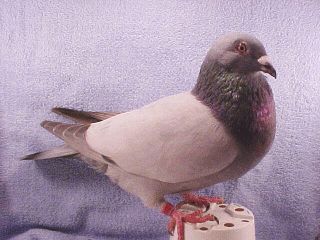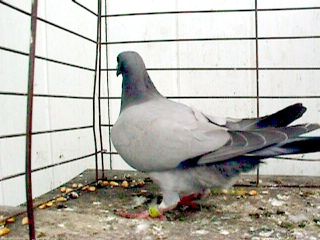
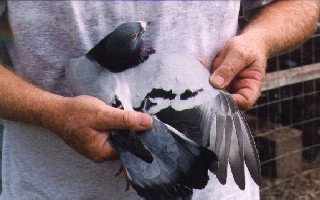
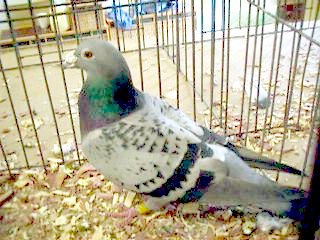
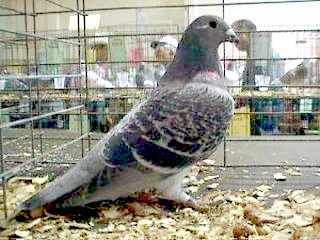

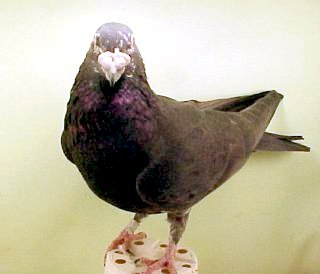
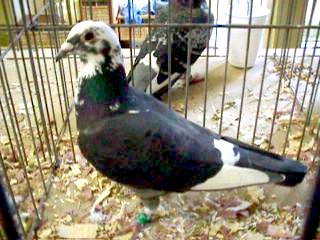
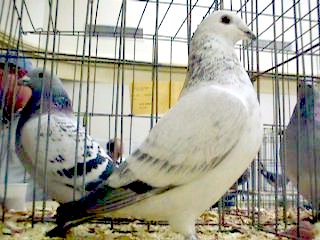
The
Blue/Black - Base Color +
Even though some of the
pigeons shown here may appear to be of other colors, genetically they
are all Blue/Black. Their appearance varies due to
differing pattern markings such as Barless c; Bar
+; Checker C and T-Pattern Check or Velvet CT
and other modifier genes, Dominant Opal Op;
Recessive Opal o; Qualmond STQ;
Indigo In; Reduced r; Dilute d; Grizzle
G; Spread S etc. just to name a
few. The combinations are numerous and
varied as is their actual appearances.








Blue Bar or Basic "Wild Type" (+)
Wild Type is the basic color and pattern of a Blue Bar. It's genetic symbols are +//+. It is a light blue with black pattern bars. Note the wing bar pattern as well as the black tail bar pattern. This bird carries no genes that have been modified. All of its genes are referred to as the wild form which is thought to be the original phenotype for all domestic pigeons. All the genes that go into making this color and pattern are given the same symbol + to denote blue bar pigeons. It is the reference or starting point for all mutations that would effect a change in appearance. In other words the symbol for bar is + and the symbol for blue/black is also +, the symbol for any other non-mutated gene is also +. For more information see Genetic Symbols and Chapter 1 - Genes, Chromosomes, Sex and Color.
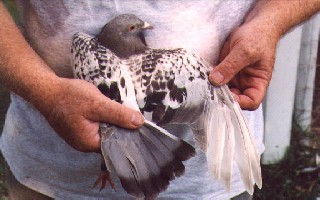
Dilute Blue colored Silver Check hen = d+/-, C//C
The standard blue check patterns vary from light checker to heavy dark check patterns. The tail remains unchanged from the bar pattern above. The bird depicted here is a dun colored Silver Check hen which is genetically d+/-, C//C a dilute blue check. It carries the modifying gene know as Dilute d which lightens the birds color and produces a brownish/black color know as dun and not the blueish/black colors of the standard Blue Check.

Black Velvet or T Check pattern with Kite bronze cock (+//+) (CTK//CTK)
This is what many refer to as a Bronze Velvet. It is the result or combination of three genes; namely Blue for color (+), T-Pattern or Velvet (CT) for pattern markings and Kite bronze (K) which is one of the various forms of Bronze. Without the Kite Bronze factor, this bird would almost be black. Only the under portions of the wing would show white or light blue and the tail remains the standard blue with black end bar and white Albescent Strip on the two outer feathers. It is the same as the blue bar tail shown above.
There is a term know as "Wild Type" used to describe the color Blue. Just what is it?
There seems to be confusion as to the meaning of the term “Wild Type” and the color “Blue/Black”. Wild type is a concept only and it includes the color blue or black however you describe it. This is a term to describe the base line for identifying genes that have mutated. It also represents every single one of the thousands of individual genes such as the color blue that go into making up this Wild Type phenotype concept.
I seriously doubt that a true wild type has ever existed. If one were to exist then it would have to be homozygous for every gene locus. The odds of that happening are nearly impossible and are beyond reality. You could take 100,000 wild type pigeons and no two would come close to being exactly the same genetically. Since this is true then the question remains… “Just what is and what is not wild type”?
That is another debate for another time. For now we need to accept that the term “Wild Type” is only a concept. One that results in a pigeon being of the phenotype selected to represent a non mutated pigeon. This phenotype has been selected to be the basic blue bar pigeon of normal feathering with yellow eyes, other measurable traits. That is one use of the "Wild Type" term. Another is to classify all the individual genes that result in this phenotype as also being “Wild Type” genes.
Wild Type as a concept is only a tool and nothing more. The total number of genes a pigeon carries and their assigned locus remains the same regardless if wild type or mutant. Every gene has a function and if present it will attempt to perform that function. Genes are proteins and as such will do their thing. This however does not preclude or mean that another gene or protein won’t come along and modify the first function into something else, as is the case with the eye colors of the Drosophilae fruit flies. The fact that a second gene regardless of its location, even if found on another chromosome, changes the function of the first or prevents it form working does not mean that the first no longer exists. A recessive red e//e does not mean that the bird is no longer a blue or no longer a bar pattern genetically. It simply means that the blue and the bar expressions have each been modified by a pair of totally unrelated or non-allele mutants know as recessive red. On the other hand, the presence of any mutated allele will mean that the wild type or original gene type is no longer present at that locus. In short, the cause of the change from wild type is the result of a gene mutation, which in turn results in a measured change. Every thing else remains the same.
There are those that say there is no Pigment Locus! If this is true then there is no pigment being produced and all of our birds would be white. I find that hard to believe since we find evidence of pigment in the feathers; brown, blue and red. We have also found two different types of pigments in the eyes. We classify the yellow pigment as being wild type TR+ and the mutation that produces white eyes as being pearl tr. So is there a pigment locus? I think so. Are there more than one? I say yes, at least two locus points are responsible for pigment and possibly even more.
Do we know all there is to these complex questions? No. There is a lot more to learn and we need to look for ways to unravel the mysteries.
